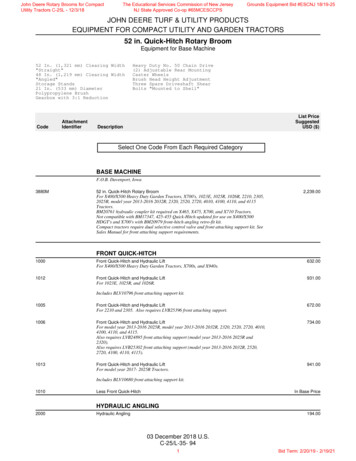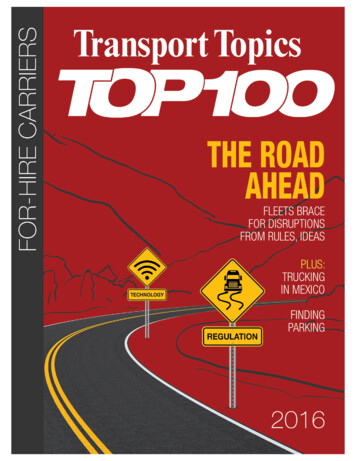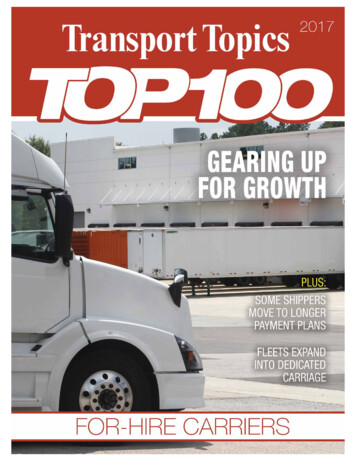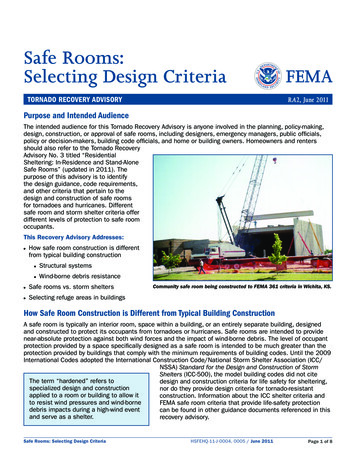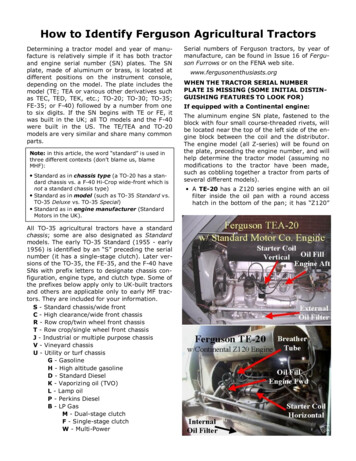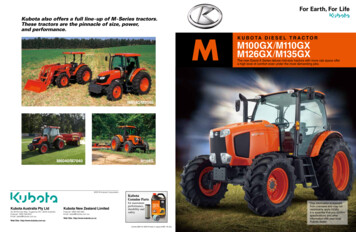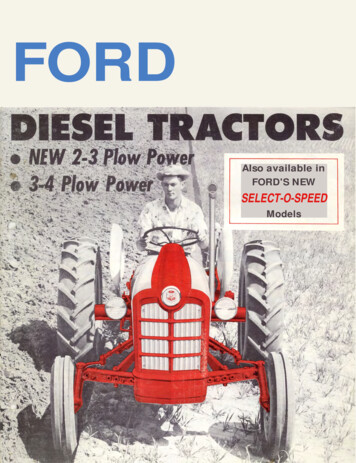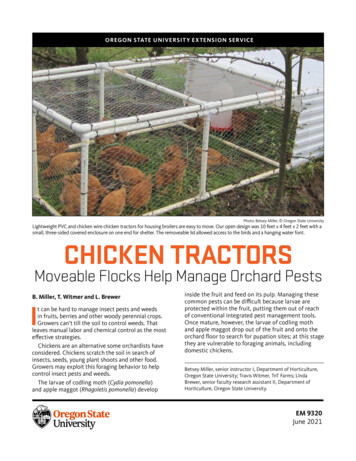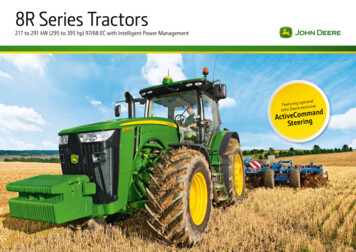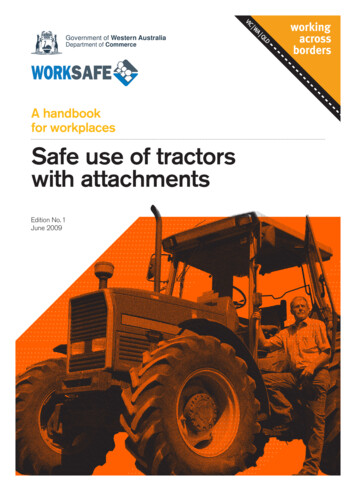
Transcription
VICDQLDepartment of Commerce WAGovernment of Western AustraliaA handbookfor workplacesSafe use of tractorswith attachmentsEdition No. 1June 2009Safe use of tractors with attachments.indd I24/12/09 11:32 AM
ContentsIntroduction2UV exposure311Legal requirements4Fatigue and stress322Common causes of injury6Working alone - communication strategies322.1 Tractor roll over6Risk of fire33Checklists348Seatbelts8Tractor maintenance checklist342.2 Tractor run over9Sample routine tractor maintenance checklist35Operator access10Pre-operation checklist3811Sample tractor pre-operation checklist38Falling Object Protective Structure (FOPS)12Tractor purchase/review checklist40Lifting and moving loads13Sample tractor purchase/review checklist4014Tractor attachmentpurchase/review checklist43Sample tractor attachmentpurchase/review checklist43Sample Front End Loader (FEL)pre-operation checklist44Sample Front End Loader (FEL)purchase/review checklist45Appendices46Appendix A:Example safe work method statementTractor and slasher46Appendix B:Example - Calculation ofrequired counterbalance488Definitions and abbreviations509References and further information51Acknowledgements522.3 Falling objects2.4 StabilityBallast and counterbalances15Axles and tyres162.5 Maintenance and repair17Maintaining a safe tractor19Older tractors202.6 Guarding - existing and retrofitted36Roll Over Protective Structure (ROPS)21Guarding requirements22Power Take Off (PTO) master guardsand shaft guards22Guarding to protect bystanders23Traffic management andthe home environment243.1 Tractor travel24People working on attachments25Transporting inoperable machinery263.2 The farm workplace andthe home environment26Separating tractors and people26Supervising children284Operator competency295Operator health30Posture30Vibration30Operator controls30Noise31Safe use of tractors with attachments.indd II7WorkSafe Victoria is a trading nameof the Victorian WorkCover Authority.This publication is protected by copyright.WorkSafe encourages the free transfer,coping and printing of this publication ifsuch activities support the purpose andintent for which this publication wasdeveloped.24/12/09 11:32 AM
This handbook has been developed by WorkSafe Victoria and the agricultural industryto encourage the safe use of tractors with attachments.WorkSafe Victoria encourages all users of tractors, especially farmers, contractors andfarm workers, to read this publication. The guidance will assist farmers to review theircurrent farm machinery to ensure that the tractor and attachment is compatible andappropriate for specific farm jobs.Led by the University of Ballarat‘s Victorian Farm Safety Centre, a reference groupof industry experts was convened to support the development of Safe use of tractorswith attachments.The purpose of this handbook is to outline the legal requirements and provide knownindustry solutions and strategies to ensure the safe operation of tractors with attachedimplements on farms.There are many abbreviations throughout this handbook. Please refer to thedefinitions and abbreviations on page 50 for complete terms and explanations.This industry safety standard has been reviewed and endorsed by:WorkSafe Western Australia. For specific occupational safety and healthrequirements refer to: Occupational Safety and Health Act 1984 andOccupational Safety and Health Regulations 1996.A handbook for workplaces Safe use of tractors with attachmentsSafe use of tractors with attachments.indd Sec1:1124/12/09 11:32 AM
IntroductionWho should read this handbook?This handbook is for farmers, their family members, employees, contractors and farmmachinery designers, manufacturer’s and suppliers. It provides advice for the safe useof tractors with attachments on farms; it does not cover industrial Front End Loaders (FEL),telehandlers or forklift trucks.This document also applies to those using tractors for other activities,such as lifestyle farming, green keeping, boating and public land management.Why should you read this handbook?Articulated dual-wheel four-wheel driveTractors are, by far, the most dangerous piece of equipment on Australian farms.About 20 people are killed on Australian farms each year while using tractors –more than the number killed by farm utilities, motorbikes and quad bikes combined.Many more people are injured. This can happen on any size of farm and to anyoneregardless of age or type of tractor.Agricultural tractors include a broad range and variety of vehicles, from aroundhalf a tonne in weight to more than 25 tonnes. They may be rigid or articulated,tyre or tracked, two-wheel drive, front-wheel assist and four-wheel drive,single or multi-wheeled per axle.Front-wheel assist with auto bucket levellingand FELTractors handle a variety of attachments. Even if the tractor itself is well set up for safeuse, a new attachment introduces a new set of hazards. Combinations of tractor andattachment require competence and experience to set up, operate and maintain.Planning and selecting the right equipment for the job is a key step before youstart. You should think through the tasks, consider the type of equipment necessaryand the terrain to ensure you select the right tractor and attachments for the job.This will result in a reduced risk of injury or death. It also includes benefits suchas better tractor efficiency, longer equipment life and lower repair costs.Articulated quad track2Safe use of tractors with attachments.indd Sec1:2A handbook for workplaces Safe use of tractors with attachments24/12/09 11:32 AM
IntroductionWhat information does this handbook contain?This handbook provides useful solutions for: preventing incidents in the first place – choosing the right tractor and attachmentsand setting them up correctly protecting the operator and others when things go wrong – through the use ofsafety guards, safe protective structures and personal protective equipment (PPE) considering the ongoing health and safety of the operator – including reducingor preventing fatigue, stress, ergonomics, noise, chemical and UV exposure.Two-wheel drive tractor with front counter weightA handbook for workplaces Safe use of tractors with attachmentsSafe use of tractors with attachments.indd Sec1:3324/12/09 11:33 AM
1.LegalrequirementsThe Occupational Health and Safety Act (OHS Act) applies to all workplaces, includingfarms. As a farmer, you may be an employer, a self-employed person or a person whomanages and controls the farm. As such, you have legal responsibilities under the OHSAct. You must ensure that, as far as is reasonably practicable, the farm workplace andmeans of entering and leaving the farm is safe and without risk to health. This extends toall people (including family members, employees, visitors, contractors or the public) toensure they are not exposed to risks to their health and safety arising from farmactivities. In certain circumstances, an independent contractor and their employees maybe deemed employees of the employer.When you are ensuring health and safety on the farm, you must do whatis ‘reasonably practicable’ having regard for the following: the likelihood of hazard or risk eventuating the degree of harm that would result if the hazard or risk eventuated what the person concerned knows or ought reasonably to know aboutthe hazard or risk and any ways of eliminating or reducing the hazard or risk availability and suitability of ways to eliminate or reduce the hazard or risk the cost of eliminating or reducing the hazard or risk.A farmer, who may be an employer, self-employed person or a person who managesor has control of the workplace, also has specific employer responsibilities to consultwith workers and provide adequate information, instruction, training and supervisionconcerning the safe use of the plant together with safe work procedures.Employees must also take reasonable care for their own and others’ health and safetyand cooperate with their employer in any actions taken to comply with the OHS Actand Occupational Health and Safety Regulations (OHS Regulations).4Safe use of tractors with attachments.indd Sec1:4A handbook for workplaces Safe use of tractors with attachments24/12/09 11:33 AM
1.Legal requirementsThe OHS Regulations provide more information about how OHS legislationshould be followed. For example, suppliers of machinery must provide adequateinformation to the purchaser at the time of supply, covering its safe use combinedwith any limitations concerning operating conditions. This includes the designerand manufacturer’s specifications, the manufacturer’s operator instruction manualon safe use, maintenance requirements, the designer and manufacturer’sspecifications for a safe workload and any compatible implements.The OHS Act also places responsibility on farm machinery designers, manufacturer’sand suppliers to ensure, as far as reasonably practicable, that the tractor andattachments are safe and without risk to health.If farmers have modified machinery, the same responsibility may apply to them.The following examples show how a farmer can be consideredunder the OHS Act to be a designer, manufacturer, or supplierof plant: As a designer of an alteration to a machine, the farmer assumes responsibilityfor any consequences that occur as a result of the alteration. The tractor shouldremain functional, stable and structurally sound and the farmer should consultwith the machine manufacturer before altering plant. One example of poor practice on farms is welding extensions onto hayforks to stop additional bales from falling back onto the tractor or operator.This destroys the forks which will need to be replaced. Farmers shouldmake enquiries with the tractor manufacturer or agent to determinewhether extension slippers that fit over the existing forks are appropriate.The increased carrying-capacity could mean the tractor and othercomponents are overloaded. A farmer makes up a carry-all platform for the three-point linkage of atractor to carry tools and supplies. Ensure the carry-all equipment undergoesappropriate load testing and the load is within the rated capacity ofthe three-point linkage and tractor to ensure the tractor remains stable.If an employee is injured because a component on the carry-all fails,the farmer assumes responsibility for any consequences of the designand manufacture under the OHS Act as the designer and manufacturer. A farmer sells a tractor with modifications to another farmer for use on a farm.If the tractor is subsequently involved in an incident and someone is injured asa result of the modification’s failure, the farmer who sold the tractor has dutiesunder the OHS Act as a supplier and may be held accountable.A handbook for workplaces Safe use of tractors with attachmentsSafe use of tractors with attachments.indd Sec1:5524/12/09 11:33 AM
2.Commoncauses of injuryFarmers need to plan and make informed choices to ensure they select the safestand most appropriate machinery and equipment for the tasks on their farms andensure safe use.The following are some industry known controls that reduce the risk of injuryor death associated with tractor operation.2.1Tractor roll overTractor roll over was until recently the single most significant cause of farmerfatality throughout Australia. The gradual introduction of Roll Over ProtectiveStructures (ROPS) has helped to reduce the number of farmer roll over fatalities.Tractor with a four-post ROPS. (Refer to page 8 for examples of two-post ROPS and fold down ROPS)6Safe use of tractors with attachments.indd Sec1:6A handbook for workplaces Safe use of tractors with attachments24/12/09 11:33 AM
2.Common causes of injuryRecommended solutionsActivityProblemSolutionsAll tractor operating conditionsRoll over and backflip Ensure tractors (over 560 kg) have a compliantROPS or ROPS-compliant cabin. Ensure the ROPS complies with AS 1636:1996Tractors - Roll over protective structure - criteria andtests and the compliance plate is attached to thestructure.Tractor travelOperating on unevenground along a roador where there is a riskof the operator beingejected from the seat Wear a seatbelt where there is a risk of beingejected from the tractor. If the tractor does nothave a seatbelt it should be retrofitted, wherereasonably practicable, to tractors that havebeen fitted with a ROPS.Using tractor for vehicle recoveryor pulling stumpsTractor backflips Never attach a towing chain to the top link pinof the three-point linkage. Attach the towingchain as low as possible to the ground. If it is not possible to attach very low to the groundon a particular tractor, it should not be used. Do not attempt to move the impossible. Even if anattachment point is very low to the ground, a tractorwith sufficient torque and traction can still backflip. Ensure tractors are fitted with a ROPS. Ensure the chain is in good condition and hasa rated capacity sufficient for the task. Be awarethat if the chain or cable breaks, it may recoil alongits length, potentially injuring operators and others. Establish a safe work zone and exclude bystandersfrom the work area.Using tractor near buildingsTractor ROPS contactingbuilding structure Only use a tractor with a fold down ROPS if youare working near buildings or overhead structures,including trees. Fitting a long plastic (non-conductive) flexible poleto the front of the tractor is a simple solution to warnthe operator of unnoticed overhead hazards.A handbook for workplaces Safe use of tractors with attachmentsSafe use of tractors with attachments.indd Sec1:7724/12/09 11:33 AM
2.Common causes of injuryRoll Over Protective Structure (ROPS)Tractors must have a compliant ROPS fitted1. This requirement may not apply in limitedcircumstances. Since the early 1980s, all new tractors in Australia must be ROPScompliant.Two-post ROPSFold down ROPS Check all tractors to make sure the cabin or structure is ROPS compliantand not simply there for weather protection. A ROPS must be fitted to the tractor by a competent person and the meansof attachment must be as strong as the ROPS itself. Some tractors with a cast iron rear axle might not be strong enough to fit atwo-post ROPS. A four-post ROPS will better distribute the load when fitted toboth the rear axle and the chassis forward of the operator. Tractor manufacturer’sand suppliers should be consulted about the most suitable ROPS design. Where overhead hazards limit the use of a standard ROPS, a fold down ROPSshould be fitted. To ensure the operator is not ejected from the tractor, it is recommendedthat a seatbelt is fitted at the same time as fitting the ROPS.Ensure the fitted ROPS meet Australian Standard, AS 1636:1996 Tractors Roll over protective structure - criteria and tests including a verification plate fromthe manufacturer. It is critical the ROPS is not structurally modified (welded or drilled)because it could undermine its structural integrity. It is acceptable to strap or clamplightweight objects to the ROPS frame, for example, using U-bolts to attach a work lightand a strap for the electric cable. The ROPS frame should be checked at least every twoyears for damage and yearly to ensure all bolts are securely fastened.SeatbeltsTractors are often used in terrain where rocks, stumps, holes, ditches, embankments,depressions and crumbling or slippery banks exist, increasing the risk to the operatorof being ejected from the tractor.Seatbelts on tractors can save lives by preventing operators being ejected from thetractor seat. Where there is a risk of roll over, the seatbelt keeps the operator withinthe protected ROPS area and prevents the operator from being thrown in front of thewheel or implements. Where there is a risk of the operator being ejected, a seatbelt mustbe worn. If the tractor does not have a seatbelt, it is recommended that a seatbelt isfitted where reasonably practicable.Many older tractors are not fitted with seatbelts or may not have provision to fita seatbelt. There are commercial products available for older tractors that providefor the installation of seatbelts. In many cases, this involves replacing the seat andseat mount. Ensure the retrofit uses compliant equipment and is attached to suitablepoints on the tractor by a competent person. It is critical that the seatbelt is connectedto components that are at least as strong and durable as the seatbelt itself andare anchored to the tractor in a way that allows the seatbelt to be effective forall seat adjustments.AS 1636 ROPS verification plate1 See Part 4, Div 4 of the OHS Regulations for the limited circumstances.8Safe use of tractors with attachments.indd Sec1:8A handbook for workplaces Safe use of tractors with attachments24/12/09 11:33 AM
2.Common causes of injuryCase studyAn Australian farmer was travelling in top gear when the tractor became unstableon rough terrain. He was thrown in front of the front wheel and crushed, sufferingserious injuries. A seatbelt would have kept him on the tractor.2.2Tractor run overA large number of tractor-related deaths and injuries involve tractor run over.These are often a result of poor practices, including starting the tractor fromthe ground, jumping off a moving tractor and getting off a tractor withoutengaging the handbrake or park.Recommended solutionsActivityProblemSolutionsPeople riding on attachmentsRun over and otherfall injuries Never ride on attachments, including carry-allsunless the attachment is specifically designed forpeople and this will not over-load the attachment. If the attachment is specifically designed to carrypeople as part of the operation (e.g. planting orvegetable harvesting), the attachment should provideprotection from all hazards and in particular, the riskof falls, ejection and entanglement. A Front End Loader (FEL) bucket or attachmentconnected to the FEL linkages should not beused to lift people.Getting on or off a moving tractorTractor runs overthe operator Never get on or off a moving tractor. Never start or operate a tractor from the ground. Turn off the engine before dismounting. Even whendismounting to close or open a gate there is a riskof knocking the tractor into gear. Ensure the handbrake is always applied or parkmode engaged. Maintain brakes to ensure they are effectivefor all terrain and strong enough to restrain themovement of the tractor should the tractor beknocked into gear. Steps, rails and guarding should ensure the operatorsteps off outside of the rear wheel track. When dismounting do not jump off the tractor.Always use the steps and handrails with threepoints of body contact.A handbook for workplaces Safe use of tractors with attachmentsSafe use of tractors with attachments.indd Sec1:9924/12/09 11:33 AM
2.Common causes of injuryOperator accessGood cabin access can prevent slips and falls when getting on and off a tractor(particularly for less-agile operators). Many older tractors (and some newer tractors)can benefit from some simple modifications to improve safe access. When replacingan old tractor or purchasing a new tractor look for the following: stair design access is preferable to ladder (vertical) access the steps should have adequate grip in all conditions and be made ofmaterials such as wide grill mesh so that mud does not easily accumulate step design – AS 1657-1992 Fixed platforms, walkways, stairways andladders - Design, construction and installation recommends the steps beapproximately 150–200 mm when accessing the tractor, the operator should face the tractor when getting onand off, maintaining three points of hand and feet contact with the handrails andsteps. There should also be a guard between the steps and the rear tractor tyre.This is effectively a wide mud guard on the side of the vehicle to maintain sufficient ground clearance, the bottom step can be fold-upor spring loaded.Case studySteps with handrail and guard over rear wheelAn Australian farmer was thrown from the tractor seat when travelling overrough terrain. He fell in front of the rear wheel and was crushed. He was notwearing a seatbelt and there was no cabin or guarding to stop him fallingunder the rear wheel.If a tractor needs to be modified to improve access, the added components shouldnot affect its structural integrity. Modifications should be undertaken by a competentperson in consultation with the tractor manufacturer.Retrofitted access steps10Safe use of tractors with attachments.indd Sec1:10Consider using long-handled tools at ground level to avoid the need to climb toclean windows and roof. Unless specifically identified for the task by the manufacturer,components such as mudguards or bonnets should not be used as access platforms.Consider using adjacent platforms and secure ladders when servicing the engine bay.A handbook for workplaces Safe use of tractors with attachments24/12/09 11:33 AM
2.Common causes of injury2.3Falling objectsMany farmers have been killed and injured by falling objects.Examples include: objects falling from Front End Loader (FEL) attachments,hay bales falling from a haystack or overhead branches falling from trees.A safe system for lifting includes both the appropriate lifting attachment for thematerial being handled and a suitable Falling Object Protective Structure (FOPS)on the tractor.Hay spike with rear frameRecommended solutionsActivityProblemSolutionsHandling hay and wrapped silageFodder can roll backor fall from a stack ontothe tractor operator Select the right attachment for the job.The tractor should have a hay spike for hayor a grab for wrapped silage. This decreases therisk of fodder rolling back onto the tractor operator.Flat forks or buckets are not appropriate. Tractors should have a suitable FOPS ora FOPS-compliant cabin. Select the appropriate FEL for the task. It shouldbe self-leveling with hydraulic load-limiting valvesto avoid overloading.Using a tractor without a cabinwith a FEL and a rear mountedtwo-post Roll Over ProtectiveStructure (ROPS) but no FOPSThe operator has noprotection from fodderor other items that may fallfrom the FEL or a nearbystack or trees where thereis a risk of falling branches Fit a suitable FOPS and select self-leveling forks orattachment that’s fitted with a rear frame to preventload from rolling back onto operator. Retire tractors that are not suited to the task anduse tractors that incorporate a ROPS and FOPS. A mid-mounted two-post ROPS does not fulfill therequirement of acting as a FOPS, especially aroundtrees and haystacks.Farmer uses a FEL to lift a generatorfrom the back of a vehicle.Components could fail,destabilising the tractor,or the operator to bestruck by brokencomponents Check that the tractor has rated lifting locationsspecified on the FEL. Consult farm machinerysupplier and manufacturer’s specifications forlifting advice including lift ratings and locations. Check the tractor’s lift capacity. Determine whethera counterbalance is necessary to achieve therequired capacity. Find out the weight of the generator (this may beon the specification plate). Use components suchas chain and shackles that have an identified ratedcapacity that is appropriate for the lift. Lift the generator from the specified lifting points.A handbook for workplaces Safe use of tractors with attachmentsSafe use of tractors with attachments.indd Sec1:111124/12/09 11:34 AM
2.Common causes of injuryFalling Object Protective Structure (FOPS)If there is a risk that the tractor operator can be harmed by falling objects,an appropriate, suitably located means of protection must be installed.For example, tractors with a Front End Loader (FEL) must be fittedwith attachments that are designed to contain the load and provideappropriate overhead protection for operators.Self-levelling FEL attachment withROPS cabinSimilarly, any tractors near objects that could fall on the operator should befitted with a suitable structure for protection. The Australian Standard for FOPS isAS 2294.1:1997 Earth-moving machinery - Protective structures. There are two levelsof FOPS protection in this Standard. For most agricultural applications, the applicableprotection is level two. A four-post ROPS may afford the operator some protection.Not all tractor cabins have been designed to meet FOPS standards. Insist on checkingfor compliance when planning the job and selecting a tractor with an attachmentsuitable to undertake this type of work.A common tractor configuration is a smaller tractor with a FEL, a two-post ROPS,but no FOPS. Anyone supplying and using these tractors should ensure thatadequate protection from nearby falling objects is included. Where the tractor withFEL configuration is not fitted with FOPS, the FEL use should be restricted to freeflowing material only – such as sand, gravel, and grains.The frames or cabins on many older tractors are not ROPS-compliant; they were onlydesigned to keep out the weather. These structures are not strong enough to protectthe operator from being struck by a falling object or as a result of a tractor roll over.Case studyAn experienced farm worker was lucky to survive when several large squarehay bales were dislodged by the FEL from a haystack falling onto the roof ofthe tractor. Fortunately, the tractor was fitted with a FOPS-compliant cabin,which saved his life.Case studyA farmer was killed when a round hay bale rolled back and crushed him.The hay was incorrectly being lifted using forklift-style tynes rather thana hay spike. The tractor had not been fitted with a compliant FOPS.12Safe use of tractors with attachments.indd Sec1:12A handbook for workplaces Safe use of tractors with attachments24/12/09 11:34 AM
2.Common causes of injuryLifting and moving loadsThe farmer or contractor, in consultation with operators, should plan the job and considerwhether the selected tractor and attachment with lifting components are suitable for theload being moved.Tractor operators should only lift using components that are specifically designed andhave a rated capacity. Operators should not use unrated components or componentsrated for other purposes, such as towing. Only use rated lifting components and onlyattach to specifically designed, rated and identified lift points on the tractor.Verification plate with rated load capacityfor FELLoad ratings for the three-point linkage and the FEL on a tractor are determined underideal conditions, such as being on solid, level ground and stationary. To ensure stableoperation and to avoid damage to components, operators should never exceed the ratedload limits and should consider the ground being travelled over and speed of travel.When assessing the load being lifted by either the three-point linkage or the FEL,consider the following: dead load – the rated capacity generally includes the weight of the attachment itself density of load – a denser load will weigh more than a less dense load for the samebucket cubic capacity load centre – as the distance between the centre of the load and the tractorincreases, the lifting capacity decreases (below the identified rated load capacity) components – various components involved in load lifting will have different ratings.Select lifting components that have the manufacturer’s marked rated capacity(eg the tractor, the FEL, the FEL attachment and any lifting gear, such as hooks,shackles, chains or slings). The lowest rating of all of these components indicatestheir maximum lifting load ground speed – depends on the terrain and load. A tractor carrying a load is lessstable when it is moving. The safe lifting capacity will be less than the identifiedrated capacity if the tractor is moving terrain – rough, undulating terrain, hilly gradients and hidden objects such asholes and rocks can reduce the rated capacity of the tractor and make it unstable counterbalance – to achieve the maximum rated capacity, and not overload thetractor, a counterbalance is required at the front or rear of the tractor to offset anyadded weight.It is good practice to retrofit a hydraulic valve that limits the maximum force appliedthrough the hydraulics to less than the rated capacity. This protects the equipmentand ensures the rated capacity of the tractor’s components cannot be exceeded.A handbook for workplaces Safe use of tractors with attachmentsSafe use of tractors with attachments.indd Sec1:131324/12/09 11:34 AM
2.Common causes of injury2.4StabilityThe safety and structural integrity of a tractor is adversely affected if it is loaded,counterbalanced or ballasted incorrectly.Tractor with good weight balanceRecommended solutionsActivityProblemSolutionsOverloading tractor three-pointlinkageTractor can be unstable,leading to loss of controlor component failure Keep load within all rated capacities, including anyrequirement for counterbalance weights at the frontof the tractor.Tractor has mounted tank forspraying or liquid transportTractor instability due toliquid movement or highcentre of gravity Fitting baffles in tanks reduces liquid movement. Stabiliser bars or chains on three-point linkage willprevent sideways movement of the tank. Ballast will lower the centre of gravity.Loading Front End Loader (FEL)Tractor has two loadratings for a FEL.Which is applicable? If there are two load ratings for a FEL, confirm withthe manufacturer or the operator’s manual, what isthe specific tractor configuration for each load rating. The hydraulics should have load-limiting valvesto avoid overloading the components.Tractor driven on road at speedThe tractor tyres areunevenly inflated Tyre pressures should be even and set forroad travel according to the manufacturer’sspecifications. Your speed should be appropriate for road conditions.14Safe use of tractors with attachments.indd Sec1:14A handbook for workplaces Safe use of tractors with attachments24/12/09 11:34 AM
2.Common causes of injuryBallast and counterbalancesBallast refers to weight that is added to the tractor’s axles. For newer tractors withradial tyres, this is added by attaching weig
Edition No. 1 June 2009 A handbook for workplaces Safe use of tractors with attachments VIC V I C W A QLD Government of Q L Western Australia D Department of Commerce SSafe use of tractors with attachments.indd Iafe use of tractors with attachments.indd I 224/12/09 11:32 AM4/12/09 11:32 AM
